What impact did the volcanic eruption in AD 536 have on European migration? Was a calm spell of weather a precondition for the Islamic invasions of the Islands and Northern Shores of the Mediterranean? Did the crusaders loose their hold on Palestine because weather-conditions in Europe deteriorated?
One of the side effects of the need to understand climate change in the 21st century has been a recent boom in historical studies of climatic shifts. It stands to reason that predicting future climate change and its causes needs detailed information of what climate was like in the past and its reflection of external forces (solar activity and volcanic eruptions). Juggling a wide variety of traces in tree-rings and ice-cores and studying maximum latewood density, sediments and pollen have accordingly been big business. However as a boon, historians now have much more precise understandings of climatic situations at specific times and in diverse regions; and hence, the possibility of linking these climatic shifts and events to particular historical happenings. [1]
But not only that! In the last few years, more and more detailed studies have been helping us to better understand the impact of climate on history inside smaller regions. This has led to a whole new genre: local or regional histories of settlements (expansions and contractions), demographic shifts and in a wider perspective, regional migratory movements. In the following, a number of specific cases will be presented. Links lead to more detailed presentations.
Late Antique Little Ice Age AD 536 – 660
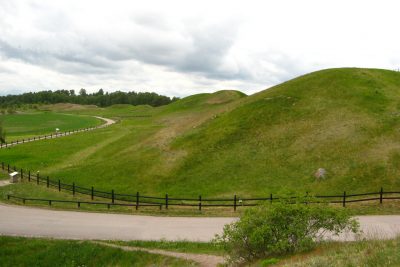 It must have take a huge effort to raise these mounds at a time, when work-power was severely curtailed. Source: Wikipedia
It must have take a huge effort to raise these mounds at a time, when work-power was severely curtailed. Source: WikipediaIn AD 536, 540 and 547 volcanic eruptions caused a sudden and prolonged cooling off in the northern hemisphere, which continued to set its mark on the average summer temperatures in Europe and further East. Recently the double event of two major volcanic incidents has been characterised as “considered together had a stronger impact than any other volcanic e.... New series of measurements of tree-ring width samples from Russia have demonstrated that these effects were not just of local European character. Rather, there is a ample evidence that these climatic incidents can be directly linked to such major historical events as the onset of the Justinian Plague, the collapse of the Northern Wei Dynasty, the migration of the Avars into Eastern and Central Europe. In the same period the Proto-Slavic dialects spread across continental Europe representing a demographic push and sending the Lombards towards Italy (AD 568). [2]
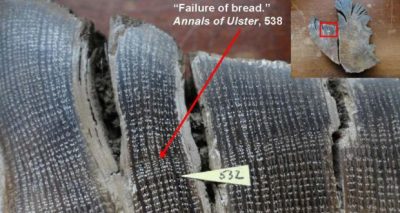 An ancient Irish oak sample from a bog in Ulster shows narrowing of tree rings indicating very dry conditions leading to the “failure of bread”, as described in the Annals of Ulster. Source: Francis Ludlow
An ancient Irish oak sample from a bog in Ulster shows narrowing of tree rings indicating very dry conditions leading to the “failure of bread”, as described in the Annals of Ulster. Source: Francis LudlowIn a very local context, the events around 536 – 40 have been linked with a probable demographic crisis in the 6th century in the valley of Mälaren (near Stockholm), which led to large-scale abandonment of land. In a wider perspective it has been argued that this brought about a renegotiation of property rights, where survivors sought to increase their acquisition of large landholdings. On effect was – perhaps – the formation of a more stratified social structure and an elite, whose remains were laid to rest in the Vendel Burial Grounds north of Uppsala, manifesting the new property rights. Moving such large amounts of earth on that scale symbolised the potential to rule over (or invest in) large groups of people for the sake of raising memorials for important chieftains and warriors. [3]
Droughts and Violence in Dark Age Ireland
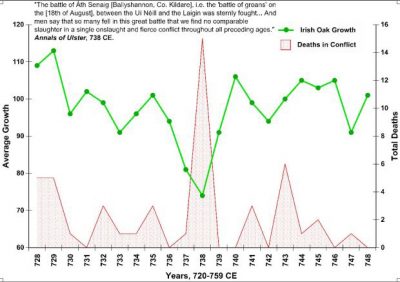 Graphic: Peak of deaths in conflict match up with severe drought. Source: Francis Ludlow. Published at a conference in Vienna 2016. According to the streamed press conference, the direct linkage between drought as documented by three rings and reported violence can be found during the whole period here considered.
Graphic: Peak of deaths in conflict match up with severe drought. Source: Francis Ludlow. Published at a conference in Vienna 2016. According to the streamed press conference, the direct linkage between drought as documented by three rings and reported violence can be found during the whole period here considered.Ireland holds of of the oldest bodies of written literature in Europe. Arguably, the most important source are the Irish Annals recording events as far back as the 5th century. The earliest evidence for one of its authors place him in Iona sometime after AD 563, while the most recent study of the Chronicles argues that a capacity for accurate chronicling in the most difficult of circumstances existed in an Irish monastic context already by 538 AD and possibly before. The most common record is obituaries. however, the chronicles also hold direct references to climatic episodes like extreme cold weather, wind, rain and floods. Working with these records, Geographer Frank Ludlow has compared them with more hard-core records of climatic events like volcanic eruptions.
In a recent article an exploratory case-study was published in which the chemical fingerprints of major volcanism in Greenland ice-cores for the years 670–730 CE were considered together with evidence from frost-rings, tree-ring growth width and density minima from Europe, Siberia and China. These records were then considered together with Western European, Near Eastern and Chinese documentary evidence. This revealed a striking sequence of co-occurring between inter-regional climatic extremes and social crises. The authors also examined a recently proposed 7-year adjustment to the chronology used by many Greenland ice cores and found an improved agreement with the evidence from measurements of tree-ring width and written records. “Three major volcanic events can now be identified, dated to 681, 684–686 and 706–707, with several moderate events further contributing to a sustained climate perturbation reflected in prolonged temperature reductions in high-resolution reconstructions”, writes the authors. This leads to a positive assessment of the possibility of using climatic records in annals and later journals and diaries, when trying to grasp the connection between extreme climatic incidences and historical events like famines, social uprisings, violence and migrations. Historians should however beware of factoring in an “inflation” in the records (in the Irish records estimated to amount to a 27.7% inflation in total) [4].
The Early Medieval Warm Period AD 725 – 1025
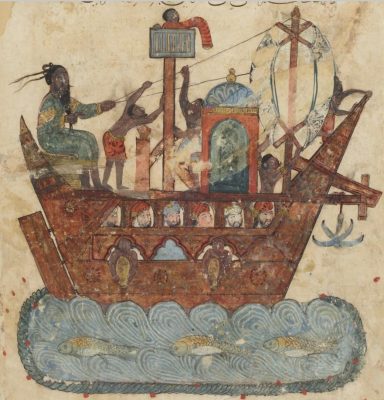 Abu Zayd and al-Harith sailing, AD 1237. BnF, manuscript Arabe 5847 fol 119
Abu Zayd and al-Harith sailing, AD 1237. BnF, manuscript Arabe 5847 fol 119It has also been hypothesized that the cooling, which lasted until the mid 7thcentury helped growth of scrub vegetation in the Arabic Peninsula furthering larger camel herds and the transportation of Arab (Muslim) armies, ultimately leading to destabilization and shrinkage of the Byzantine Empire.
What is perhaps more pertinent is the way in which the following period was not only characterised by a prolonged “heat-wave” but also a marked lack of noticeable external forces leading to climatic havoc. Few volcanic events and little solar activity in the period from AD 725 – 1025 have made some climate historians rename the period: the Medieval Quiet Period. [5]
These results has been supplemented by a recently published study of sediments in lagoons around Languedoc, which have contributed to this discussion by showing the linkage between cool periods and stormy weather in the North Western Mediterranean. In fact, the cooling of the climate, which took place in the 5th century and onwards was accompanied by the highest storm activity over the past three millennia. So far this observation has not resulted in careful analysis of the economical impact on maritime trade, port infra structure and the use of coastal natural resources (fishing). On important hypothesis might be that the calm weather, which seemed to follow in the 9th century, was one of the very important preconditions for the consolidation of the Muslim presence on Cyprus, Malta, Sicily, Sardinia and the Balearic Islands (to name but a few) post 800. In a further perspective the relative calm period in the 9th century, which can be detected in the analysis of the sediments in the lagoons in Southern France may also be indicative of a comparable calm period in the Northwestern and Arctic Sees, in which the Vikings operated (when they were not competing with the Muslims in the Mediterranean). [6]
The Colonization of North Eastern Europe AD 900 – 1400
At the same time Russian scientists have worked to try and correlate the slow movement of settlers into the region bordering on Karelia and further east. These studies have shown that Slavs and Scandinavians carried out the initial settlements east of Estonia. This led to a later consolidation around Novgorod in the 10th century and was followed by expansions into the North, first by hunters and later by peasants. What is interesting, though, is that it has been possible to show that warm periods ignited an interest to move further North, while subsequent cold periods slowed the expansion down. [7]
The Levant
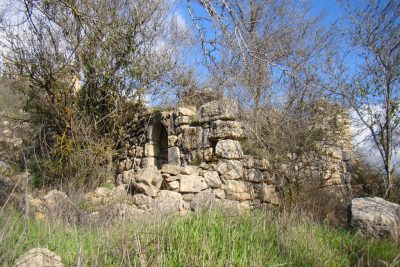 Ruin of Belmont Castle in Israel. Source: Panoramio
Ruin of Belmont Castle in Israel. Source: PanoramioAt the other end of Europe the early Crusaders were initially favoured by a relatively calm climate, which did not deteriorate until later in the 12th century and 13th century. The wind blew the ships calmly to the shores of Palestine carrying not only soldiers but also victuals and materials needed to wage war in this corner of the world. However, later the surplus of production in Europe deteriorated and necessary supplements of grain did not arrive even though series of droughts and plagues of locusts and rodents plus earthquakes contributed to a more and more precarious situation for the Christian colonists in the Levant. A recent book by Sarah Kate Raphael has helped to explore the many details in this sorry story. She concludes that warring took full bellies and the deterioration of climate in the 12th and 13th century (not least the droughts) often led to the cessation of hostilities. However, after the worst drought 1178 – 1181, Saladin – who operated out of Egypt – was able to conquer Jerusalem and confine the Crusaders inside a narrow strip of land along the coast. Bereft of agricultural land, they became even more dependant on help from the Crusading nations and the Papal State back in Europe. This, however, became steadily less generous. In 1270 Louis IX died in Tunis, ending the last major attempt to retake the Holy Land by retaking Egypt and Cairo. A major precondition for success was that whenever drought and famines threatened in the Levant, the climate in Egypt was propitious. Thus, the Muslims could count on help from this region, which lies in another climatic zone than the Levant, while the living conditions for the Christian settlers slowly deteriorated. Elaborate and glittering crusades were launched form time to time – especially to regain control with Egypt – but the steady support to the settlers and the Kingdom of Jerusalem was obviously less flashy. In the end of the 13th century, the adventures in Levant came to a brutal end, when Acre was taken [8].
Cold Summers and The Plague
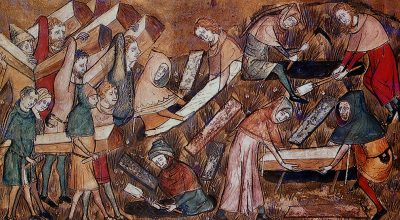 The burial of the victims of the plague in Tournai. Detail of a miniature from “The Chronicles of Gilles Li Muisis” (1272-1352), abbot of the monastery of St. Martin of the Righteous. Bibliothèque royale de Belgique
The burial of the victims of the plague in Tournai. Detail of a miniature from “The Chronicles of Gilles Li Muisis” (1272-1352), abbot of the monastery of St. Martin of the Righteous. Bibliothèque royale de BelgiqueIt is well-known that the plague, which hit Europe in AD 1348 and caused the death of countless people was preceded by a major famine, 1315 – 1322, which was caused by extraordinarily wet weather. However, the deteriorating living circumstances were felt even earlier in the mid 13th century. One reason was the major volcanic event at Samalas in Indonesia, which exploded some time between May and October 1257. The effect could be felt all over Europe and is witnessed by a number of writers. The English chronicler Matthew Paris wrote that during this year “the north wind blew without intermission, a continued frost prevailed, accompanied by snow and such unendurable cold, that it bound up the face of the earth, sorely afflicted the poor, suspended all cultivation, and killed the young of the cattle to such an extent that it seemed as if a general plague was raging amongst the sheep and lambs.”
Recent comparative studies of survivorship of people in the early and late pre-plague periods (the 11th – 12th centuries compared to the 13th century) have shown that it deteriorated significantly in the 13th century, when mean survival was 31.63 years as opposed to the earlier 38.19 years. It has been speculated that this is a sign of a less robust health. People were simply considerably weakened; this eventually led to a more severe set of consequences of the plague, when it finally hit Europe in 1348.
The Future
It appears from these studies that a whole new crop of climate historians are finally warming up to the more detailed studies, which the field deserves and which have been made possible by the large scale climatic histories which are being published as we write. Even if the historic events cannot be directly linked to corresponding climatic events, a whole new field seems to be unfolding – that of understanding concrete historic weather conditions as preconditions for directions and scope of human activities in a broader context.
NOTES:
[1] Medieval Summer Temperatures in Europe – Medieval Histories
[2] Late Antique Little Ice Age AD 536 – 660 – Medieval Histories
[3] The Dust Veil AD 536 – Medieval Histories
[4] Droughts and Violence in Dark Age Ireland
[5] The Medieval Warm and Quiet Period – Medieval Histories
[6] Stormy Weather in The Early Middle Ages – Medieval Histories
[7] Medieval Climate Shifts and Settlements in North Eastern Europe – Medieval Histories
[8] Environmental Disasters in the Medieval Levant – Medieval Histories
[9] Setting the Stage for the Medieval Plague – Medieval Histories
FEATURED PHOTO:
Andreas Achenbach: Sunset after a Storm on the Coast of Sicily © The Met Museum
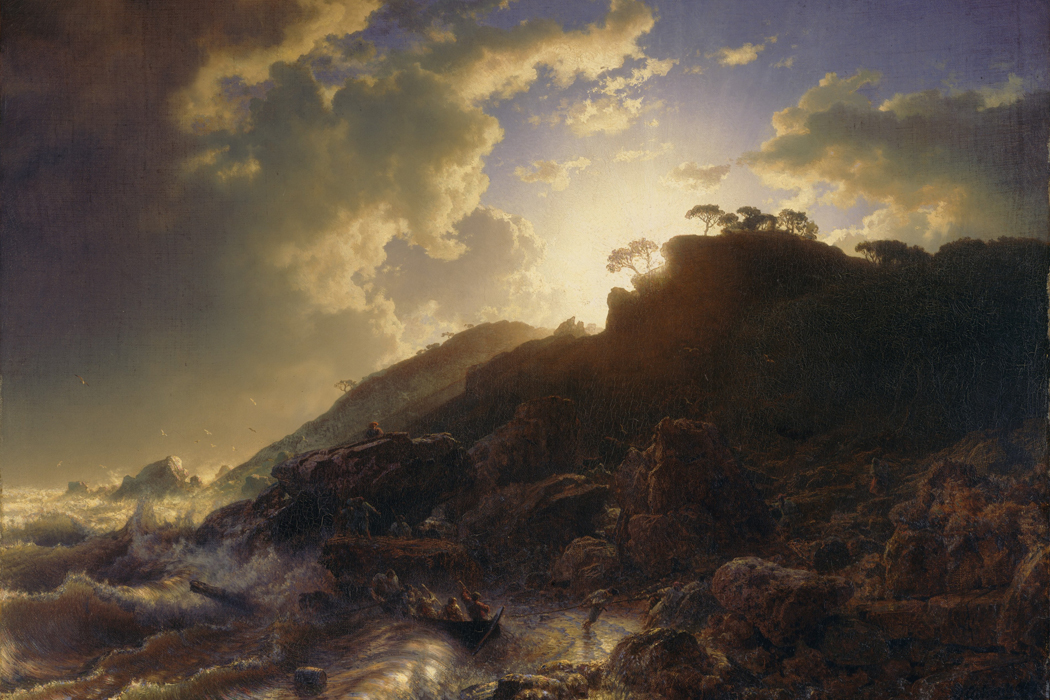 http://www.medievalhistories.com/wp-content/uploads/Andreas-Achenbach-Sunset-after-a-Storm-on-the-Coast-of-Sicily-Met-Museum-400x267.jpg 400w,
http://www.medievalhistories.com/wp-content/uploads/Andreas-Achenbach-Sunset-after-a-Storm-on-the-Coast-of-Sicily-Met-Museum-400x267.jpg 400w, 












Pentru a putea adăuga comentarii trebuie să fii membru al altmarius !
Alătură-te reţelei altmarius